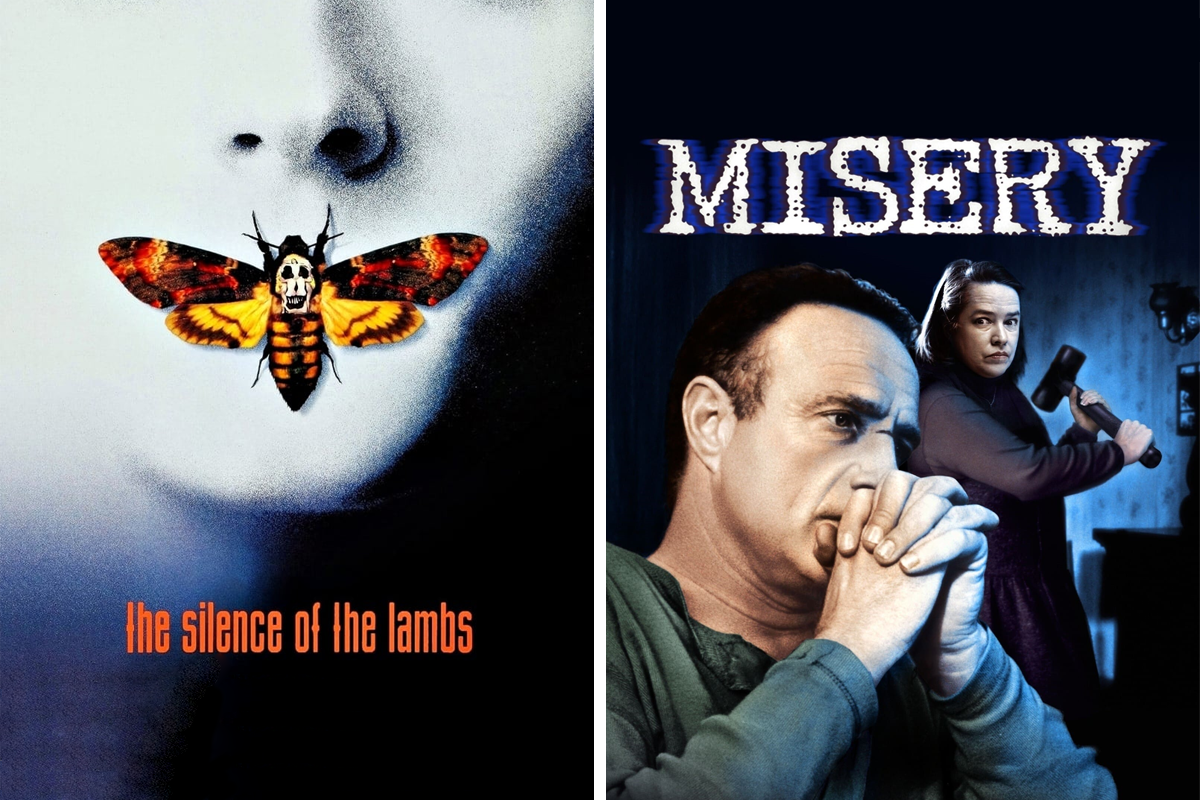Psychological Thrillers for Mature Viewers delve into the darker aspects of the human psyche, exploring complex themes and morally ambiguous characters. These films often utilize intricate narrative structures, unreliable narrators, and unsettling atmospheres to create a deeply engaging and thought-provoking experience. The mature content necessitates a careful consideration of the potential psychological impact on viewers, demanding a nuanced understanding of the ethical implications involved in depicting violence and disturbing subject matter.
This exploration will examine the defining characteristics of mature psychological thrillers, analyzing key themes, narrative techniques, character development, and the role of setting and atmosphere in shaping the overall impact. We will also consider the evolution of the genre, its various subgenres, and the lasting effect these films have on audiences.
Defining “Mature Viewers”
Defining “mature viewers” in the context of psychological thrillers requires considering both age and the capacity to process complex and potentially disturbing themes. It’s not simply a matter of chronological age, but also a level of emotional and intellectual maturity necessary to understand and engage with the film’s content without undue distress or misinterpretation.
Thematic elements significantly differentiate mature-themed psychological thrillers from those aimed at younger audiences. Mature thrillers often explore morally ambiguous characters, complex psychological issues such as trauma, mental illness, and abuse, and graphic depictions of violence or disturbing situations. These elements are generally absent or significantly toned down in films targeting younger viewers, who may lack the emotional resilience and cognitive development to process such content appropriately.
Age Ranges and Maturity Levels
Generally, “mature viewers” for psychological thrillers are considered to be individuals aged 18 and older. However, this is a broad generalization. A 17-year-old with a high level of emotional intelligence and exposure to complex themes might be more equipped to handle a mature thriller than a 25-year-old with limited experience in such areas. The key is the viewer’s ability to critically analyze the narrative, understand its underlying themes, and process potentially disturbing content without experiencing significant emotional distress or developing unhealthy coping mechanisms. Factors such as prior exposure to violence, mental health awareness, and overall emotional maturity all contribute to a viewer’s readiness for such films. Some individuals may find themselves emotionally unprepared for mature content even at older ages, while others may be well-equipped to handle complex themes at a younger age.
Content Appropriateness Across Maturity Ratings
The following table compares the content appropriateness of psychological thrillers across different maturity ratings, illustrating the typical themes and content associated with each. It’s important to note that these are general guidelines, and individual films within a rating category can vary significantly in their content.
| Rating | Typical Age Range | Content Examples | Limitations/Considerations |
|---|---|---|---|
| PG-13 | 13+ (parental guidance suggested) | Suggestive themes, mild violence, thematic elements of psychological suspense, but limited graphic depictions. | May still contain scenes that are unsettling for younger viewers; parental discretion is advised. Intense psychological themes are often minimized or simplified. |
| R | 17+ (restricted; under 17 requires accompanying parent or adult guardian) | Strong language, violence, disturbing themes, sexual content, graphic depictions of psychological manipulation or violence. | Significant level of psychological and/or physical violence; intense themes that may be disturbing for some viewers. |
| NC-17 | 18+ (no one under 17 admitted) | Explicit sexual content, graphic violence, extreme disturbing themes. Often features unflinching portrayals of psychological trauma and violence. | Not suitable for minors; contains content that is highly disturbing and graphic in nature. |
Key Themes in Mature Psychological Thrillers

Mature psychological thrillers delve into the darker recesses of the human psyche, exploring complex moral dilemmas and the fragility of sanity. These films often utilize recurring themes to unsettle and provoke viewers, prompting reflection on the nature of reality, identity, and the consequences of our choices. The psychological impact on the viewer stems from the identification with flawed characters, the unsettling ambiguity of narratives, and the exploration of disturbing subject matter.
Psychological thrillers for mature audiences often achieve their unsettling effect through the strategic use of several key thematic elements. These themes are not mutually exclusive; rather, they often intertwine to create a deeply disturbing and thought-provoking viewing experience. The exploration of these themes can lead to a profound, albeit sometimes uncomfortable, examination of the human condition.
Moral Ambiguity and the Blurring of Good and Evil
Mature psychological thrillers frequently present characters whose morality is far from clear-cut. The lines between protagonist and antagonist become blurred, forcing the viewer to question their own judgments and preconceptions. This ambiguity creates suspense and keeps the audience engaged, constantly questioning the motivations and actions of the characters. The psychological impact lies in the unsettling realization that even seemingly good characters can harbor dark secrets, and that morality is not always straightforward.
- The Silence of the Lambs (1991): Clarice Starling’s moral compromises in her pursuit of Hannibal Lecter.
- Prisoners (2013): The desperate measures taken by the parents to find their missing daughters.
- Nightcrawler (2014): Lou Bloom’s descent into amorality in his pursuit of success.
The Fragility of the Human Psyche and the Nature of Reality
Many mature psychological thrillers explore the fragility of the human mind, questioning the reliability of perception and memory. Characters often grapple with mental illness, trauma, or deception, leading to unreliable narration and ambiguous plot lines. This creates a sense of unease and uncertainty for the viewer, forcing them to question what they see and hear on screen. The psychological impact is a feeling of disorientation and a questioning of one’s own perception of reality.
- The Machinist (2004): Trevor Reznik’s descent into paranoia and insomnia.
- Shutter Island (2010): Teddy Daniels’s struggle to uncover the truth amidst his own mental breakdown.
- Black Swan (2010): Nina Sayers’s blurring of reality and fantasy as she prepares for a demanding role.
Trauma and its Lingering Effects, Psychological Thrillers for Mature Viewers
The exploration of trauma and its long-term effects is a common theme in mature psychological thrillers. These films often depict characters struggling with the psychological consequences of past events, leading to unpredictable behavior and flawed decision-making. The psychological impact on the viewer is a heightened awareness of the lasting effects of trauma and the importance of mental health.
- The Girl with the Dragon Tattoo (2011): Lisbeth Salander’s struggle with her traumatic past.
- Manchester by the Sea (2016): Lee Chandler’s grief and guilt following a tragic event.
- The Killing of a Sacred Deer (2017): Steven Murphy’s confrontation with the consequences of his past actions.
Identity and the Search for Self
Mature psychological thrillers often feature characters grappling with questions of identity, exploring themes of self-discovery, deception, and the masks we wear in society. This can involve characters struggling with their true selves, assuming false identities, or undergoing dramatic transformations. The psychological impact is a reflection on the viewer’s own sense of self and the complexities of human identity.
- Fight Club (1999): Jack’s creation of an alter ego to escape his mundane life.
- Memento (2000): Leonard Shelby’s struggle to piece together his fragmented memory and identity.
- American Psycho (2000): Patrick Bateman’s exploration of identity and the superficiality of wealth and status.
The Exploration of Obsession and Control
Many mature psychological thrillers center on the theme of obsession, exploring the destructive nature of unchecked desires and the lengths to which individuals will go to maintain control. This can involve stalking, manipulation, or even violence, creating a sense of unease and suspense for the viewer. The psychological impact is a chilling examination of the human capacity for obsession and the potential for its destructive consequences.
- Cape Fear (1991): Max Cady’s relentless pursuit of Sam Bowden and his family.
- Misery (1990): Annie Wilkes’s obsessive devotion to her favorite author.
- Fatal Attraction (1987): Alex Forrest’s obsessive pursuit of Dan Gallagher.
Narrative Structures and Techniques
Mature psychological thrillers often utilize sophisticated narrative structures to manipulate audience expectations and maximize suspense. The choice between linear and non-linear storytelling significantly impacts the viewer’s experience, shaping their understanding of the plot and characters. Effective use of unreliable narrators, foreshadowing, and suspense techniques are crucial in crafting a truly gripping and memorable narrative.
Successful mature psychological thrillers frequently play with the traditional linear narrative structure. While some films opt for a straightforward chronological approach, many others employ non-linear storytelling, jumping between timelines or presenting events out of order. This technique creates intrigue and allows for gradual revelation of crucial information, keeping the audience guessing and actively engaged in piecing together the puzzle. For instance, *Memento* uses reverse chronology to build suspense and challenge the audience’s understanding of the protagonist’s fragmented reality. Conversely, a film like *The Silence of the Lambs* employs a largely linear narrative but strategically inserts flashbacks and foreshadowing to enhance the overall tension.
Nonlinear Storytelling and its Impact
Nonlinear narratives in psychological thrillers often serve to amplify the psychological aspects of the story. By disrupting the chronological flow, the filmmaker can create a sense of disorientation and unease that mirrors the mental state of the characters. This disjointed structure can also heighten the sense of mystery and suspense, as the audience is forced to actively participate in reconstructing the narrative. The film *Pulp Fiction* exemplifies this, weaving together multiple narratives in a non-chronological manner, blurring the lines between reality and perception. The impact on the audience is a heightened sense of involvement as they are forced to actively piece together the narrative.
Unreliable Narrators and Audience Engagement
The use of unreliable narrators is a powerful tool in mature psychological thrillers. An unreliable narrator, whose perspective is skewed or deceptive, forces the audience to question everything they see and hear. This ambiguity creates a compelling sense of uncertainty, making the audience actively scrutinize the events unfolding on screen and the motivations of the characters. *Gone Girl* masterfully utilizes an unreliable narrator to manipulate the audience’s perception of the protagonist and the events surrounding his wife’s disappearance. The audience is left constantly questioning the truth, actively engaging with the narrative to determine the true nature of the situation. This ambiguity leads to greater audience engagement and a more impactful viewing experience.
Foreshadowing and Suspense Techniques
Foreshadowing and suspense are essential elements in crafting a truly thrilling psychological experience. Foreshadowing, the subtle hinting at future events, builds anticipation and keeps the audience on the edge of their seats. Suspense, on the other hand, is the feeling of anxious uncertainty about what will happen next. Mature thrillers often combine these techniques to create a layered and complex narrative that keeps viewers deeply invested. The use of visual cues, dialogue, and even the soundtrack can all be employed to subtly foreshadow impending events, while carefully paced reveals and cliffhangers sustain the suspense. The classic film *Psycho* is a prime example, employing both foreshadowing and suspense to build towards its iconic climax. The unsettling score, combined with the subtle visual cues and dialogue, contributes to a growing sense of dread and anticipation, making the shocking climax all the more effective.
Character Development and Psychology
Mature psychological thrillers thrive on the complexities of their characters, often presenting individuals who defy simple categorization as heroes or villains. These characters are frequently morally ambiguous, their actions driven by a tangled web of psychological motivations that keep audiences guessing until the very end. Understanding these motivations is key to appreciating the genre’s depth and impact.
The psychological depth of characters in mature psychological thrillers is often explored through nuanced portrayals of their internal conflicts, past traumas, and flawed decision-making processes. The narrative often delves into the characters’ backstories, revealing the events and relationships that have shaped their present selves and contributed to their current predicaments. This exploration allows the audience to empathize with even the most unsettling characters, understanding their motivations even if they don’t condone their actions.
Examples of Complex and Morally Ambiguous Characters
Many characters in mature psychological thrillers exhibit traits that blur the lines between protagonist and antagonist. Consider the character of Patrick Bateman in “American Psycho,” whose meticulously crafted exterior masks a violent sociopath. His actions are driven by a deep-seated insecurity and a need for control, masked by his superficial charm and success. Similarly, Amy Dunne in “Gone Girl” manipulates her husband and the public, revealing a complex personality driven by a need for power and revenge stemming from a perceived betrayal. These characters are not simply “bad guys”; their complexities make them compelling and unsettling. Their actions, though reprehensible, are rooted in understandable, albeit warped, psychological motivations. Their internal struggles, often hidden beneath a façade of normalcy, are central to the narrative’s suspense and psychological exploration.
Psychological Motivations Behind Character Actions
The actions of characters in mature psychological thrillers are seldom straightforward. They are usually the result of a complex interplay of factors, including unresolved trauma, deep-seated insecurities, repressed desires, and manipulative tendencies. For example, a character might commit a seemingly inexplicable act of violence due to a past experience of abuse or neglect. Another might engage in elaborate schemes of deception to compensate for feelings of inadequacy or to achieve a desired outcome, even if it means harming others. The exploration of these underlying psychological factors is crucial to understanding the characters’ motivations and the overall narrative arc. The thrill of these stories often lies in unraveling these complexities, making the audience question their own perceptions of morality and human nature.
Psychological Profiles of Characters
The following table Artikels the psychological profiles of three distinct characters, highlighting their key traits and motivations:
| Character Name | Film/Book | Key Psychological Traits | Motivations |
|---|---|---|---|
| Patrick Bateman | American Psycho | Narcissistic, sociopathic, superficial, violent, insecure | Control, power, self-validation through violence and material possessions |
| Amy Dunne | Gone Girl | Manipulative, cunning, intelligent, vengeful, emotionally unstable | Revenge, power, control over her husband and public perception |
| Norman Bates | Psycho | Schizophrenic, deeply disturbed, obsessive, mother-fixated | Protection of his idealized mother figure, stemming from severe childhood trauma |
The Role of Setting and Atmosphere
Setting in a mature psychological thriller isn’t merely backdrop; it’s a crucial character, actively shaping the narrative’s mood and driving the suspense. The environment reflects the protagonist’s internal turmoil, amplifies the threat, and contributes significantly to the overall feeling of unease and dread. A carefully crafted setting can foreshadow events, create a sense of isolation, and even manipulate the audience’s perception of reality.
The effective use of visual and auditory elements is paramount in building a chilling atmosphere. Visual elements, such as decaying architecture, oppressive shadows, or unsettling landscapes, immediately establish a tone of unease. These visual cues subtly communicate the psychological state of the characters and the inherent dangers lurking within the narrative. Similarly, auditory elements, such as unsettling soundscapes, echoing whispers, or the persistent drip of water, contribute to a heightened sense of suspense and dread. These sounds often work subconsciously, creating a persistent feeling of unease that permeates the narrative. The combination of visual and auditory cues establishes a powerful and immersive experience for the viewer, pulling them into the heart of the psychological tension.
Visual and Auditory Elements in Creating Atmosphere
Consider the classic gothic horror trope of a decrepit mansion shrouded in perpetual mist. The decaying stone, the ominous shadows cast by the gnarled trees, the eerie silence punctuated by the creak of old wood – all these visual and auditory elements combine to create an atmosphere of palpable dread. This is not merely a setting; it is a character itself, reflecting the decay within the protagonist’s mind and the sinister secrets hidden within its walls. The visual elements of darkness and decay reflect the inner darkness and disintegration of the protagonist’s mental state, mirroring the unsettling events that unfold. The auditory elements of silence and creaking further amplify this unease, constantly reminding the audience of the potential for sudden, terrifying events. This technique is used effectively in numerous psychological thrillers to enhance the unsettling atmosphere and keep viewers on the edge of their seats.
Illustrative Example of Setting and Atmosphere
Imagine a scene in a remote, snow-covered cabin nestled deep within a vast, unforgiving forest. The only light source is a flickering fireplace, casting dancing shadows across the snow-covered walls. Outside, a howling wind whips through the skeletal branches of the trees, its mournful cry echoing through the silence. Inside, the protagonist, haunted by a traumatic past, sits alone, the only sound the crackling fire and the rhythmic tick-tock of a grandfather clock, each tick a reminder of the relentless passage of time and the ever-present threat. The stark contrast between the warmth of the cabin and the hostile wilderness outside mirrors the protagonist’s internal conflict, while the ominous sounds of the wind and the clock create a sense of impending doom. This combination of visual and auditory elements paints a vivid picture of isolation, vulnerability, and mounting psychological tension, effectively immersing the viewer in the protagonist’s terrifying reality. The oppressive silence punctuated by the howling wind and ticking clock serves to amplify the feeling of isolation and dread, enhancing the psychological tension of the scene. The stark, minimalist setting enhances the feeling of claustrophobia and vulnerability, making the protagonist’s plight all the more affecting.
Exploring Moral Ambiguity and Complex Choices
Mature psychological thrillers thrive on presenting viewers with morally ambiguous situations, forcing them to confront uncomfortable truths and question their own ethical compass. The characters often grapple with dilemmas that defy easy categorization as “good” or “bad,” blurring the lines between right and wrong and compelling viewers to engage with the complexities of human behavior. These narratives don’t offer simple solutions; instead, they highlight the messy reality of moral decision-making under pressure.
The exploration of these dilemmas challenges the viewer’s perception of right and wrong by presenting situations where the “right” choice leads to unintended negative consequences, or where the “wrong” choice seems necessary for a greater good. The narratives often exploit the inherent subjectivity of morality, demonstrating how different individuals might interpret the same situation differently, depending on their backgrounds, beliefs, and personal stakes. This forces the audience to actively participate in the moral judgment process, rather than passively accepting pre-defined notions of good and evil.
Moral Dilemmas in Psychological Thrillers
Several prominent psychological thrillers utilize moral dilemmas to drive their narratives. In “The Silence of the Lambs,” Clarice Starling must cooperate with the cannibalistic Hannibal Lecter to catch another serial killer, forcing her to confront the ethical implications of using a monster to achieve justice. Similarly, in “Seven,” Detective Mills faces a horrifying choice at the end, grappling with the moral implications of his actions and the consequences of his failure to prevent a series of gruesome murders. These examples illustrate the complex ethical terrain navigated by characters in the genre, where the pursuit of justice often requires morally compromising actions.
Analysis of a Moral Choice in “The Dark Knight”
A compelling example of a difficult moral choice is presented in Christopher Nolan’s “The Dark Knight.” In a pivotal scene, Batman (Bruce Wayne) faces the decision of whether to kill the Joker, a chaotic and amoral villain who threatens to detonate multiple bombs across Gotham City. The Joker, representing absolute nihilism, forces Batman to confront the very foundation of his own moral code, which prohibits killing.
This scene presents a classic utilitarian dilemma: sacrificing one life (the Joker’s) to save the lives of countless others. However, the film doesn’t provide a simple answer. Batman’s refusal to kill, despite the immense pressure, reinforces his commitment to his principles, even if it means accepting significant risk. This choice, however, also highlights the limitations of his moral code, demonstrating the potential for catastrophic consequences when adhering strictly to principles in the face of overwhelming evil. The scene leaves the audience to ponder the validity of Batman’s decision, acknowledging the inherent complexities and potential for devastating outcomes in even the most seemingly “right” choices.
Impact on the Viewer
Mature psychological thrillers, by their very nature, delve into the darker aspects of the human psyche, exploring themes of violence, trauma, and moral ambiguity. Exposure to such content can have a significant psychological impact on viewers, ranging from mild unease to significant distress, depending on individual sensitivities and predispositions. Understanding these potential effects is crucial for both filmmakers and viewers alike.
The immersive nature of these films, often employing unsettling visuals, suspenseful soundtracks, and complex characters, can create a lingering emotional response. Viewers might experience heightened anxiety, disturbed sleep patterns, or even intrusive thoughts mirroring the film’s themes. This impact isn’t necessarily negative; for some, the cathartic experience of confronting difficult subject matter can be beneficial. However, for others, particularly those with pre-existing mental health conditions, the experience can be triggering or exacerbate existing vulnerabilities.
Ethical Considerations Regarding Violence and Disturbing Content
The portrayal of violence and disturbing content in mature psychological thrillers raises significant ethical questions. While artistic expression necessitates a degree of freedom, the potential for desensitization or the normalization of harmful behaviors must be carefully considered. Filmmakers have a responsibility to handle such content responsibly, ensuring that it serves a narrative purpose and avoids gratuitous exploitation. The use of violence should be justified within the context of the story, contributing to the exploration of themes and character development, rather than merely serving as a shock tactic. For example, a film depicting the psychological aftermath of a violent crime might be ethically justifiable if it focuses on the victim’s trauma and recovery, while a film that glorifies or sensationalizes violence for its own sake raises serious ethical concerns. The line between artistic expression and exploitation is often blurry, requiring careful consideration and responsible filmmaking practices.
Coping Mechanisms for Viewers
It’s important for viewers to recognize that experiencing heightened anxiety or distress after watching a mature psychological thriller is a normal response. However, managing these feelings is crucial for maintaining mental well-being. A variety of coping mechanisms can be employed.
Several strategies can help viewers process the emotional impact of these films. These include:
- Engaging in self-care activities: This could involve spending time in nature, exercising, listening to calming music, or practicing mindfulness techniques.
- Discussing the film with others: Sharing your feelings and interpretations with trusted friends, family, or a therapist can provide valuable emotional release and perspective.
- Seeking professional help: If you are experiencing significant distress or find that the film’s themes are triggering pre-existing mental health issues, seeking support from a mental health professional is recommended.
- Limiting exposure: If you find that watching these types of films consistently negatively impacts your well-being, it’s advisable to limit or avoid viewing them.
- Focusing on positive activities: After watching a disturbing film, actively engage in enjoyable and relaxing activities to shift your focus and mood.
Subgenres within Mature Psychological Thrillers
Mature psychological thrillers, by their very nature, delve into the darkest corners of the human psyche, exploring themes of obsession, trauma, and moral ambiguity. However, this broad category encompasses a diverse range of subgenres, each with its own distinct characteristics and narrative approaches. Understanding these distinctions helps appreciate the nuances and variations within the genre.
The subgenres often blend and overlap, creating hybrid forms that defy easy categorization. This fluidity contributes to the genre’s richness and capacity for surprising and unsettling storytelling. The lines between, for instance, a psychological thriller with horror elements and a straight horror novel with strong psychological underpinnings can be remarkably blurred.
Psychological Horror
Psychological horror utilizes the unsettling power of suggestion and dread to explore the fragility of the human mind. Unlike straightforward horror, which relies on graphic violence and jump scares, psychological horror aims to unsettle the viewer through atmosphere, ambiguity, and the gradual erosion of sanity. It often features unreliable narrators, blurring the line between reality and delusion, leaving the audience questioning the true nature of events. Examples include novels like “The Haunting of Hill House” by Shirley Jackson, which uses the oppressive atmosphere of the house itself to drive the psychological terror, and films like “The Silence of the Lambs,” where the chilling nature of Hannibal Lecter’s intellect is a primary source of horror.
Mystery Thrillers with Psychological Elements
This subgenre combines the classic whodunit structure of mystery with the exploration of psychological motivations. The focus is on unraveling a crime, but the narrative also delves into the psychological states of the characters involved, often revealing complex and unsettling truths about their pasts and present. The motivations behind the crime are as, or even more, important than the crime itself. Think of Gillian Flynn’s “Gone Girl,” where the mystery of the missing wife is intricately intertwined with the psychological manipulation and unraveling of the marriage.
Crime Thrillers with Psychological Depth
Crime thrillers typically focus on the criminal act and its investigation. However, when infused with psychological depth, the focus shifts to the criminal’s mindset, their motivations, and the psychological impact of the crime on both the perpetrator and the victim. This often leads to exploring themes of guilt, redemption, and the consequences of actions. Examples include novels like “The Girl with the Dragon Tattoo,” where the psychological trauma of the characters is a central element driving the plot, and films like “Seven,” where the psychological torment inflicted by the killer is as important as the crimes themselves.
Psychological Suspense
Psychological suspense prioritizes building tension and maintaining a sense of unease and anticipation. The narrative often revolves around a central mystery or threat, but the primary focus is on the protagonist’s psychological state as they grapple with uncertainty and fear. The suspense is built through carefully crafted foreshadowing, unreliable narration, and a gradual reveal of unsettling truths. This subgenre often avoids explicit violence, instead relying on the power of suggestion and the viewer’s imagination to create a sense of dread. Alfred Hitchcock’s films are prime examples of this, particularly “Rear Window,” where the suspense is built through observation and the protagonist’s increasingly paranoid state.
The Evolution of Mature Psychological Thrillers
Mature psychological thrillers, a genre exploring the darkest corners of the human psyche, have undergone a fascinating evolution, mirroring societal shifts and technological advancements. Early examples often focused on external threats, while modern iterations delve deeper into internal conflicts and moral ambiguity, reflecting a growing understanding of mental health and societal anxieties.
The evolution of mature psychological thrillers can be traced through several distinct eras, each marked by unique thematic concerns and cinematic techniques. Early films, often influenced by German Expressionism, utilized stark visuals and unsettling atmosphere to create suspense. Later periods saw the genre explore the impact of trauma, societal pressures, and the blurring lines between sanity and madness, reflecting changing cultural landscapes.
Early Influences and the Rise of Suspense
The genre’s foundations lie in the early 20th century, with films like Alfred Hitchcock’s “Psycho” (1960) serving as a pivotal moment. Hitchcock masterfully employed suspense, shocking twists, and psychological manipulation to create a lasting impact. This era emphasized external threats and shocking reveals, building tension through visual storytelling and masterful pacing. The film’s impact is undeniable, establishing many tropes and techniques still used today. The focus was largely on the suspense of the external threat, rather than the deep psychological exploration seen in later films. Other films of this era, while not strictly psychological thrillers, laid groundwork by exploring themes of paranoia and mental instability, influencing the genre’s development.
The Exploration of Trauma and Internal Conflicts
The latter half of the 20th century saw a shift towards exploring internal conflicts and the lasting effects of trauma. Films like Roman Polanski’s “Repulsion” (1965) and “The Tenant” (1976) delve into the fractured psyches of their protagonists, utilizing unsettling imagery and psychological realism to portray mental deterioration. These films often feature unreliable narrators, forcing the audience to question their perceptions and empathize with characters grappling with deeply personal struggles. This era reflected a growing societal awareness of mental health issues and the complexities of the human mind. The shift away from purely external threats towards internal struggles marked a significant turning point for the genre.
Modern Interpretations and Societal Reflections
Contemporary mature psychological thrillers continue to push boundaries, often exploring themes of identity, morality, and the pervasive influence of technology. Films like David Fincher’s “Se7en” (1995) and “The Silence of the Lambs” (1991) exemplify this trend, blending psychological depth with graphic violence and complex moral dilemmas. These films often reflect anxieties about societal issues, such as violence, corruption, and the breakdown of social structures. The use of unreliable narrators and ambiguous endings has become increasingly common, challenging viewers to actively participate in interpreting the narrative. The rise of streaming services and independent filmmaking has also allowed for a greater diversity of voices and perspectives within the genre.
Summary: Psychological Thrillers For Mature Viewers
In conclusion, mature psychological thrillers offer a compelling and often unsettling journey into the depths of human experience. By exploring complex themes, morally ambiguous characters, and intricate narratives, these films challenge viewers to confront uncomfortable truths and grapple with difficult moral dilemmas. While the potential for psychological impact is significant, the artistic merit and thought-provoking nature of these films make them a rewarding, albeit intense, cinematic experience. A responsible approach to viewing, including self-awareness and potential coping mechanisms, can enhance the appreciation of this genre without compromising mental well-being.






